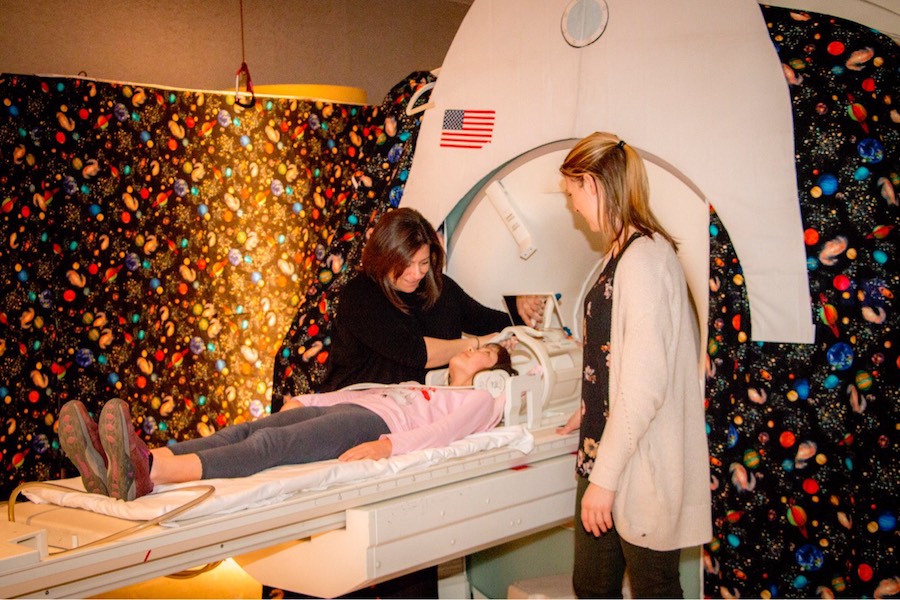
Applied behavioral analysis eliminates need for sedation in high quality brain scans, advances understanding of the disorder
Autism Spectrum Disorder (ASD) occurs in about 1 in 68 children, affecting all racial, ethnic and socioeconomic groups. The prevalence of this developmental disability prompts both researchers and impacted families to seek a better understanding of ASD.
Christine Nordahl, a UC Davis MIND Institute faculty member and an assistant professor of psychiatry and behavioral sciences, published a study on obtaining high quality Magnetic Resonance Imaging (MRI) brain scans in children with severe autism without using sedation.
Board-certified behavioral analysts worked with the children to provide a safe and comforting environment in order to achieve a successful scan.
“The MRI studies are critical for understanding differences in the brains of people with ASD, which will provide clues about the causes of the condition and eventually potential biological treatments to optimize outcomes for affected people,” said Leonard Abbeduto, the director of the MIND Institute and a professor in the Department of Psychiatry and Behavioral Sciences.
MRI scans provide information about the organs and structural components that cannot be seen with an X-ray or computed tomography (CT) scan.
The goal of the study was to understand the neural basis of autism. Before finding a treatment for the disorder, scientists must first understand what is going on in the brain.
The study aimed to gain high quality structural MRI images in children with ASD, aged 9 to 13, without using anesthesia or sedation.
“Much of the previous research using MRI has been limited to higher functioning individuals with ASD who can understand verbal instructions and can remain still in the scanner for long periods of time independently,” Abbeduto said.
The lack of MRI scans of more severely impaired individuals with ASD seriously limits the understanding and ability to develop treatments for them.
“This means that much of what we know about the brain may only be applicable to a subset of individuals with ASD,” Abbeduto said.
Previously, applied behavioral analysis (ABA) has been used to prepare children with ASD or other intellectual disabilities for clinical visits to the dentist or other medical appointments.
ABA therapy is a technique centered upon bringing positive change in behavior, often paired with social or tangible reinforcement for completion of a certain task or supportive measure.
“Essentially, we are combining the expertise of the behavioral analysts and research to get successful MRI scans,” Nordahl said.
Some of the behavioral strategies the analysts utilized were peer modeling and increasing the sense of control and motivation with the aid of positive reinforcers.
In addition, children were prompted with verbal reminders, visual timers and countdowns to help create a relaxed environment throughout the scan.
The requirements of an MRI scan include being able to lie still for thirty minutes in a confined space while being able to withstand loud banging noises from the machine.
“For a child with severe deficit or intellectual disability, this is hard for them [because] they need extra guidance and familiarization to get them through the scan,” Nordahl said.
A technique used sometimes to achieve successful MRI scans of children with ASD is the use of sedation, specifically general anesthesia. Although general anesthesia poses minimal risk, many families prefer not to have their children sedated and choose not to participate in the imaging process. This causes a lack of valuable MRI scans that could be used to study the disorder in more detail.
“There are few previous studies about analyzing MRI scans of children with severe ASD, but in those cases, those children were all sedated,” Nordahl said. “We wanted to take that [sedation] risk out.”
The researchers of the study aim to share their improved and safer methods for obtaining high-quality images in a broader spectrum of children with ASD. The ABA therapy provided by behavioral analysts was performed in a mock MRI setting to adequately prepare the child as much as possible for a successful scan. A critical component of the researchers’ success was open communication with the families of the participants.
Interaction with families is absolutely integral for obtaining successful scans and keeping the child comfortable throughout the process. For example, the child was allowed to pick their favorite movie to watch during the imaging process.
Other questions directed to the parents included how sensitive their child was to sound, and if they were able to wear headphones to perhaps block out sound or listen to music. Through open communication with families, researchers were able to achieve a 94 percent success rate of high quality MRI scans.
In regards to the scientific field studying any disorder, it is important to study as many cases as possible. These new methods combining ABA to achieve successful MRI scans has provided significant information to researchers about understanding ASD that was previously lacking.
“After seeing their child successfully complete the MRI scan, many families leave feeling very proud of their child and can’t believe their child completed it,” said Melissa Mello, a board certified behavior analyst at the MIND Center. “I think doing this successfully proves just how much children with autism are capable of.”
The authors of this study hope their methods can be used by other scientists to gather critical information about the disorder.
Written by: Shivani Kamal — science@theaggie.org



